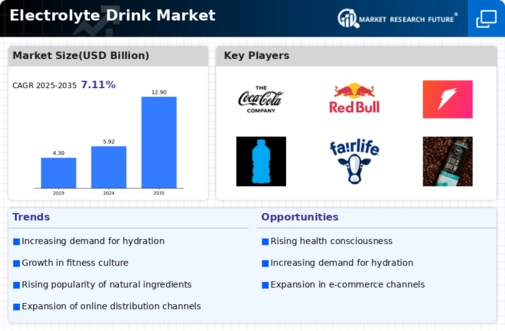Rising Sports Participation
The increasing participation in sports and fitness activities appears to be a primary driver for the Electrolyte Drink Market. As more individuals engage in physical activities, the demand for hydration solutions that replenish electrolytes becomes more pronounced. According to recent data, the sports drink segment has seen a growth rate of approximately 6% annually, indicating a robust market for electrolyte beverages. This trend is likely to continue as health-conscious consumers seek products that enhance performance and recovery. Furthermore, the rise of fitness influencers and social media platforms has contributed to the popularity of electrolyte drinks, as they are often promoted as essential for optimal athletic performance. Consequently, the Electrolyte Drink Market is poised to benefit from this surge in sports participation, as consumers increasingly recognize the importance of hydration in their fitness regimens.
Innovative Product Offerings
The introduction of innovative product offerings is a significant catalyst for growth within the Electrolyte Drink Market. Manufacturers are increasingly developing new formulations that cater to diverse consumer preferences, including organic, low-sugar, and functional beverages. This trend is evidenced by the emergence of electrolyte drinks infused with vitamins, minerals, and natural flavors, appealing to health-conscious consumers. Market data suggests that the segment of functional beverages, which includes electrolyte drinks, is projected to grow at a compound annual growth rate of 7% over the next five years. This innovation not only attracts new customers but also retains existing ones, as consumers are drawn to unique and beneficial products. As a result, the Electrolyte Drink Market is likely to thrive amid this wave of creativity and product differentiation.
Growing Demand for Convenience
The increasing demand for convenience is reshaping the landscape of the Electrolyte Drink Market. Busy lifestyles and on-the-go consumption patterns have led consumers to seek easily accessible hydration solutions. Ready-to-drink electrolyte beverages, available in convenient packaging, are becoming increasingly popular among consumers who prioritize convenience without compromising on health. Recent market analysis indicates that single-serve electrolyte drinks have experienced a surge in sales, with a growth rate of approximately 5% in the last year. This trend is expected to persist as more individuals look for quick and effective ways to stay hydrated. Consequently, the Electrolyte Drink Market is likely to expand as manufacturers respond to this demand by offering products that cater to the needs of busy consumers.
Increased Awareness of Hydration
There is a growing awareness regarding the importance of hydration, which significantly influences the Electrolyte Drink Market. Consumers are becoming more educated about the role of electrolytes in maintaining bodily functions, particularly during physical exertion. This heightened awareness is reflected in the rising sales of electrolyte drinks, which have reportedly increased by 8% over the past year. As individuals seek to optimize their health and performance, they are more inclined to choose beverages that offer electrolyte replenishment. Additionally, educational campaigns by health organizations and fitness experts further emphasize the necessity of proper hydration, thereby driving demand. The Electrolyte Drink Market is likely to continue expanding as consumers prioritize hydration and seek products that align with their health goals.
Shift Towards Healthier Lifestyles
The ongoing shift towards healthier lifestyles is a pivotal driver for the Electrolyte Drink Market. As consumers become more health-conscious, they are increasingly seeking beverages that contribute positively to their overall well-being. This trend is reflected in the rising popularity of electrolyte drinks, which are perceived as healthier alternatives to traditional sugary beverages. Market data indicates that the demand for low-calorie and functional drinks has surged, with electrolyte drinks capturing a notable share of this market. This shift is further supported by the growing trend of clean eating and natural ingredients, as consumers favor products that align with their health values. As a result, the Electrolyte Drink Market is likely to continue flourishing as it adapts to the evolving preferences of health-oriented consumers.


















Leave a Comment